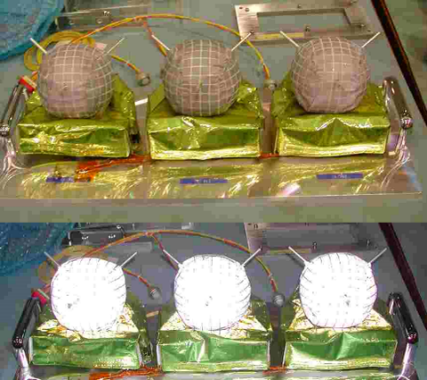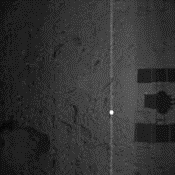Back to List
Analysis of Target Marker's Dynamics

本研究は,はやぶさ2が自律的な誘導航法のために,目印として小惑星に向けて投下したターゲットマーカーの挙動を解析するものである.ターゲットマーカーは,多数の小球を含むことで,跳ね返り抑制を実現しているが,このメカニズムを解明し,より跳ね返りにくい小惑星探査用のペイロード設計指針を提示する.
Hayabusa2 used artificial landmark called Target Marker (TM) as a navigation aid. To mitigate the rebound motion on an asteroid surface, the TM is composed of a shell and hundreds of small balls. Due to the collision among small balls dissipating the energy, rebound motion becomes smaller. We evaluate the rebound mitigation performance and translational motion after the rebound. This study contributes to the design of payloads in asteroid missions.
Abstract
はやぶさ2のターゲットマーカー(TM)投下では,TMが小惑星に投下し静止できたが,跳ね返り抑制メカニズムは完全に解明されてはいない.このメカニズムの解明は,将来の小惑星ペイロード設計のために重要である.本研究では跳ね返り抑制メカニズムを解明し,TM中に含んだ小球の半径や個数を含めた最適な設計を提案する.
TMの跳ね返り抑制は,個別要素法によってシミュレーションを行った.また,落下塔実験による微小重力実験を行い,比較・評価を行った.また,水平方向の運動についても検討を行い,移動しにくい形状の考察も行った.
本研究は,小惑星上でペイロードが余計なリバウンドを行うことを防ぐことに貢献する.本研究の成果により,微小重力環境へのペイロード投下がより信頼できるものになり,小惑星近傍フェーズでの運用の幅を広げることが出来る.
Although Hayabusa2’s Target Marker (TM) deployment showed that the TM can be deployed and settled under microgravity, the mechanism of the rebound damping is not fully explained. Understanding the rebound mitigation mechanism is necessary to improve the rebound damping performance of new payloads for future small body missions. Therefore, this study elucidates the mechanism of rebound mitigation and proposes an optimal design including the inner balls’ number and radius.
The rebound motion of a TM is simulated by a discrete element method. In addition, we have conducted a microgravity environment experiment in a drop tower. Comparing the result of the experiment and simulations, TM’s rebound performance is evaluated. In addition to the rebound mitigation effect, we consider the translational motion of a TM. We have investigated the shapes that can effectively stop translational motion in a microgravity environment.
The contribution of this study is that we offer the design criteria for a payload to deploy to the asteroid surface in order to prevent unnecessary rebound motion. This study enables a more reliable payload deployment in microgravity environments, resulting in broader options in a proximity phase of a small body mission.

